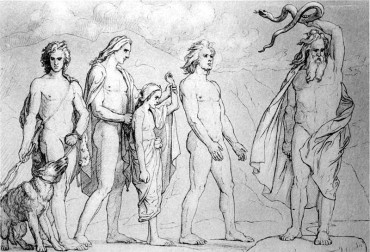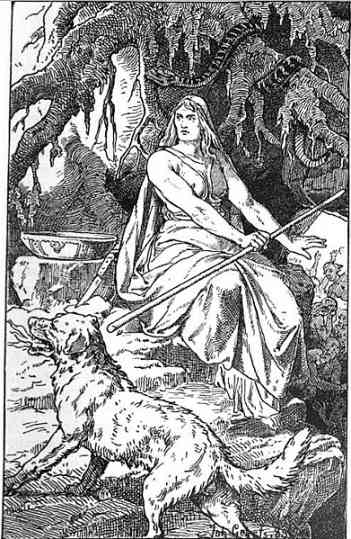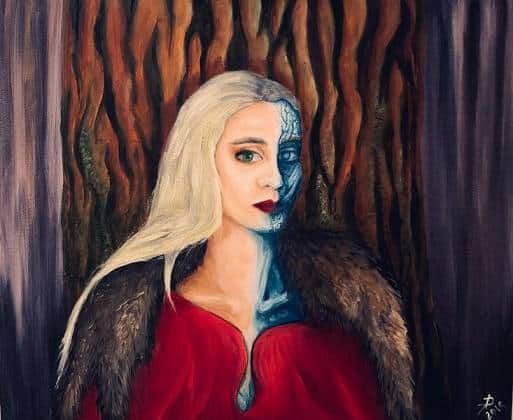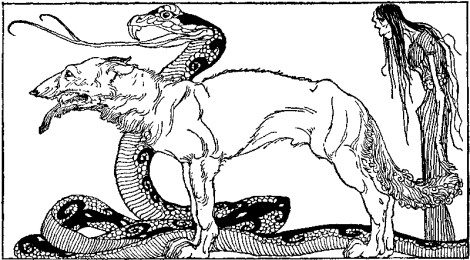Hel, a significant figure in Norse mythology, often evokes intrigue and curiosity. While many are familiar with the likes of Odin and Thor, Hel’s story is a deep dive into the nuances of life, death, and what lies beyond.
Hel Key Facts
| Parents | Loki and Angrboda |
| Partners | None known |
| Siblings | Fenrir and Jormungandr |
| Offspring | None |
| Tribe | Jötun |
| Old Norse name | Hel |
| Other names | None known |
| The God of | Death and the Underworld |
| Ass. Animal | None known |
Name and Etymology
Hel’s name in Old Norse, “hel,” carries profound implications, suggesting both an “underworld” and something “hidden.” This intertwining of the deity’s identity with her domain reflects the depth of her character. Hel, both the goddess and the realm, stands at the crossroads of the seen and the unseen, known and the mysterious.
The Old Norse divine name Hel isn’t just a title; it’s a reflection of the very essence of her role. The name’s origin can be traced back to the Proto-Germanic feminine noun haljō, which means ‘concealed place’ or ‘the underworld.’ Other ancient languages, such as Gothic and Old English, have similar terms—Gothic “halja” and Old English “hel” or “hell”—highlighting the shared cultural significance of this mysterious realm across different traditions.
Ancient Origins
While Hel’s direct name is unique to Norse mythology, themes of underworld rulers can be found in many cultures. Germanic traditions hint at an underworld figure, though not directly aligning with Hel. Such cross-cultural motifs highlight the universality of grappling with life, death, and the hereafter.
Hel’s Origins and Family Ties

Born to the mischievous god Loki and the jötun Angrboda, Hel’s lineage is as tumultuous as it is captivating. With brothers like Fenrir, the formidable wolf, and Jormungandr, the world-encircling serpent, her destiny was intertwined with significant events from the start. The Aesir, the principal group of deities in Norse mythology, regarded their birth with a mix of anticipation and trepidation.
Helheim – Realm of Solitude
However, unlike many gods, Hel didn’t engage in numerous, or any, romantic escapades. Subsequently, she never had any offspring either. Instead, her narrative is more driven by her paternal ties and role as ruler of Helheim.
With a father known for his cunning and deceit and brothers destined for chaos, her life was a tapestry of complex dynamics and significant events. Hel’s domain, while somber, also provided solace and peace to souls who didn’t meet their end on the battlefield, reinforcing her nuanced role in the grand scheme of Norse mythology.
Hel’s Banishment: Echoes in Mythology
Hel’s descent into the underworld and her subsequent rule over it is a narrative that reverberates across various mythologies. This journey of gods or divine entities, from celestial realms to the shadows of the underworld, is an archetypal tale that illuminates shared human fears, hopes, and interpretations of the afterlife.
The Fall of Lucifer
Lucifer, originally one of the most admired angels in Christianity, experienced a dramatic fall from grace. Due to his pride and desire to usurp God’s throne, he was cast out of Heaven. This fall led him to become Satan, the ruler of Hell, and the embodiment of evil. The narrative of Lucifer’s descent mirrors Hel’s exile from Asgard, both driven by higher powers and fated to rule domains of the dead and the damned.
Hades and the Underworld
In Greek mythology, Hades, along with his brothers Zeus and Poseidon, drew lots to decide who would rule over which realm. Hades became ruler of the underworld, a domain later referred to by his own name. Although he didn’t experience a fall in the same manner as Hel or Lucifer, Hades willingly accepted his role, understanding its necessity in the cosmic order. The underworld, while often associated with death and despair, also held Elysium, a paradise for heroic souls.
Hel’s Roles and Responsibilities

In the tapestry of Norse mythology, Hel’s dominion over the underworld weaves a tale rich in symbolism, shedding light on the Norse understanding of life, death, and the worlds in-between. Let’s explore her responsibilities and the nuances of her realm.
A Realm of Symbolism
Hel was cast into Niflheim by Odin, a realm often enshrouded in mists and associated with the spirits of the deceased. Within this expanse, there’s an intriguing interplay between Helheim and Niflheim. Some sources suggest Helheim is a part of the greater Niflheim, while others argue that Helheim is a distinct realm, carved out from Niflheim itself. This ambiguity highlights the intricate and sometimes overlapping nature of the Norse cosmology.
Hel’s responsibility encompassed dominion over nine distinct worlds. Her role was to ensure souls, especially those departing from ailments or the weight of time, found their rightful place in the afterlife, preserving the delicate balance between life and death.
Her residence in Niflheim was more than just a grand mansion—it was a symbolic manifestation of her role. The imposing walls and grand gates of her abode serve as markers of her vast responsibility. And within this realm, symbolism abounds. Eljudner, her resonant hall, seems imbued with the spirits of those who’ve passed on. The very objects within her hall bear names steeped in meaning: a table named “famine” and a knife known as “starvation,” hinting at the trials souls might encounter. Even her servants, Ganglate and Ganglot, embody the relentless flow of time and the inevitable decay.
Hel and the Afterlife – Choices and Consequences
Hel’s dominion, while vast and encompassing, wasn’t the sole destination for souls in Norse mythology. In fact, the Norse cosmos offered a multi-dimensional afterlife. Warriors who died bravely in battle were believed to be taken to Valhalla or Fólkvangr, realms overseen by Odin and the goddess Freyja respectively, to prepare for the cataclysmic event of Ragnarök.
Those who found themselves under Hel’s watch, however, had typically met their end through sickness, age, or causes other than glorious combat. Yet, it’s important to clarify that being in Hel’s realm wasn’t synonymous with damnation or eternal suffering. This was different in the Viking Age view of Hel and the afterlife. For the most part, souls in Hel’s care experienced a rather neutral existence, akin to a continuation of their earthly lives.
However, there were darker corners in this vast realm, notably Náströnd (the “Corpse Shore”). This was the dreaded place where malefactors, particularly murderers, oath breakers, and other egregious wrongdoers, were sent. Here, they faced their just retribution, enduring punishments befitting their earthly transgressions. So, while Hel’s realm was vast and varied, the justice meted out within its boundaries was finely nuanced, reflecting the complexities of life, death, and the shades of morality in between.
Depiction, Characteristics, and Symbols of Hel

Hel’s portrayal in Norse mythology intertwines her physical appearance with the symbols and attributes of her realm, melding them into a narrative that offers profound insights into the Norse perception of the afterlife.
A Dual Visage: Half-Blue, Half-Flesh
Hel’s striking appearance is an amalgamation of two contrasting shades: one half of her is blue, reminiscent of the lifeless cold, while the other half bears the hue of living flesh. This duality might be interpreted as a representation of the thin line between life and death, or perhaps as a reflection of the dual nature of her realm, which is both a place of rest and a reminder of the inexorable march of time. Her stern and grim countenance underscores her formidable role as the guardian of the dead, leaving an indelible impression on those who would dare venture into her dominion.
Symbols: The Mansion and Its Inhabitants
Hel’s grand mansion, with its towering walls and imposing gates, is a testament to her significant stature within the Norse pantheon. Named Eljudner, her hall isn’t just a dwelling but a symbol of her dominion over death and the afterlife. Within this mansion, every object and entity has a story to tell, serving as allegorical representations. Her table, named “famine”, and her knife, known as “starvation”, may signify the challenges and tribulations souls encounter in her realm. Meanwhile, her attendants, Ganglate and Ganglot, embody the inevitable passage of time and decay.
Garm: The Guardian Hound
Beyond the walls of Hel’s mansion lies another vital symbol: Garm (or Garmr), her loyal guardian hound. This fierce beast stands as both a protector and a gatekeeper, ensuring that the boundaries between life and the afterlife remain inviolate. Garm’s role resonates with other mythologies where guardian creatures stand sentinel at the gates of the underworld, emphasizing the universality of such symbols across various cultures.
Myths about Hel
Hel’s narrative in Norse myths might not be as extensive as some gods, but where she appears, the stories are unforgettable. They shed light on her character, her realm, and her interactions with other deities.
Hel and Her Brothers’ Origins

When Angrboda, a giantess, bore three children by Loki, the heavens trembled. These offspring—Hel, Fenrir the wolf, and Jormungandr the world-serpent—were destined to play pivotal roles in the fate of the cosmos. Alarmed by their foretold destinies, the Aesir decided to intervene. Hel was cast into the realm of the dead, where she would reign as its queen. Fenrir, meanwhile, was bound (though not without consequence), and Jormungandr was thrust into the world’s oceans, where he encircled Midgard.
Baldur’s Death and Hel’s Decision
The beloved god Baldur’s death is a turning point in Norse mythology. After his untimely demise due to Loki’s mischief, the gods, mourning deeply, sought to retrieve him from Hel’s grasp. Upon their plea, Hel posed a condition: Baldur would be released if all beings, living or dead, wept for him. And so, the world wept, save for one—a giantess (suspected to be Loki in disguise) who refused. Thus, Baldur remained with Hel, solidifying the tragic event that would lead to further tensions among the gods.
Hel’s Role in Ragnarok
The end of times, Ragnarok, is a cataclysmic event where destinies unfold, and Hel’s role is monumental. Leading an army of the dead, she marches against the gods, uniting with her brothers and other forces of chaos. This culminating battle signifies the cyclical nature of Norse myths; an end that’s also a beginning. Hel’s participation underscores her importance, reminding all of her profound dominion over life’s final passage.
Mentions in Ancient Texts
Throughout Norse literature, Hel is mentioned numerous times, highlighting her importance in the pantheon and the reverence or fear she instilled in the people of that time. Here’s a breakdown of her mentions in various primary sources:
Prose Edda
Gylfaginning
Hel’s genesis and her connection with Loki and Angrboða are elaborated in the Gylfaginning. It is by far the greatest source for information about her. The narrative depicts her as one of three offspring—along with Fenrir and Jörmungandr. Once the gods recognized the potential threat they posed, each was cast into different realms, with Hel being placed in Niflheim. Her dominion is described in detail, marking her as a being with a realm that mirrors her persona: a mix of darkness and neutrality.
“Hel is “half black and half flesh-coloured,” adding that this makes her easily recognizable, and furthermore that Hel is “rather downcast and fierce-looking.”
Skáldskaparmál
Hel is invoked in several kennings within the Skáldskaparmál, connecting her to Baldr’s fate and offering a poetic lens through which to view her.
“Hel’s companion” and “Hel’s […] relative or father”.
Poetic Edda
Völuspá
The Vôluspá provides glimpses into Hel’s realm, particularly the “Halls of Hel”.
“Halls of Hel.”
Grímnismál
Hel’s association with Yggdrasil, the world tree, is established in the Poetic Edda poem Grímnismál.
Hel is listed as living beneath one of three roots growing from the world tree Yggdrasil.
Other stanzas from Fáfnismál, Atlamál, and Baldrs draumar expand on the roles and reputation of Hel within the context of Norse cosmology.
Heimskringla
Ynglinga saga
This saga, penned by Snorri Sturluson, doesn’t directly name Hel but offers significant inferences. It provides a depiction of Hel’s interaction with kings, reaffirming her role in determining the fate of souls.
“Loki’s sister Yngvi’s heir o’er all Sweden.”
In successive chapters, the tale of King Eystein Halfdansson and others further enhance our understanding of Hel’s reach in the mortal world.
“Loki’s child from life summoned to her thing the third liege-lord, when Halfdan of Holtar farm left the life allotted to him.”
Other Sources
Egils saga
In the poem Sonatorrek, attributed to the 10th-century skald Egill Skallagrímsson, Hel is subtly referenced in the context of death and mourning.
“Now my course is tough: Death, close sister of Odin’s enemy stands on the ness: with resolution and without remorse I will gladly await my own.”
Each of these mentions not only cements Hel’s importance in Norse lore but offers readers a diverse range of interpretations and understandings of her character.
Frequently Asked Questions
Hel governs Helheim, the underworld where those who didn’t die a heroic or notable death reside.
She’s the daughter of Loki and the giantess Angrboda.
Not necessarily. While she oversees the dead, she’s more neutral, embodying both life and death.
Her relationships are mainly familial, especially with her brothers Fenrir and Jormungandr.
She’s often seen as half alive, half dead, showcasing her duality.
Hel is prophesied to lead an army of the dead during the final battle of Ragnarok.
Play Fun Norse Quiz
Is this article making you even more curious about Norse gods and goddesses? You can satisfy your curiosity by playing a fun Norse mythology quiz. This way, you can test your knowledge about Norse gods and goddesses, as well as fill in some gaps. Good luck and have fun playing!
If you found this quiz fun, go check out all the other quizzes on our Games page here!
